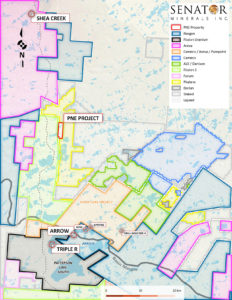Senator outlines plans for Athabasca Basin uranium project


Senator Minerals Inc. [SNR-TSXV] said Friday January 5 that it is planning a 10-hole, 6,500-metre diamond drill program at its Patterson Northeast uranium project in northern Saskatchewan’s Athabasca Basin. Subject to financing, the aim is to test for subsurface uranium, the company said.
The move comes just weeks after the company said Cameco Corp.‘s [CCO-TSX, NYSE-CCJ] decision to suspend production at the McArthur River Mine represents an opportunity for strategic acquisitions in the sector at an opportune time in the market.
McArthur River is the world’s largest operating uranium mine, accounting for about 10% of global production. The decision to suspend production removes about 17 million pounds of annual uranium production from the supply chain.
Senator said it remains firmly committed to the exploration of its highly prospective projects in the Athabasca Basin, where it controls the PNE and Carter Lake projects. Carter Lake adjoins Cameco’s Hook Lake project to the south. Down-hole drilling at Hook Lake has already tested positive for uranium enrichment.
The PNE Project is located on the prolific east side of the Athabasca Basin in northern Saskatchewan. PNE covers approximately 531 hectares, directly adjoining the eastern boundary of the Fission 3.0 Corp. [FUU-TSXV] Patterson Lake North Project. The PNE project was previously explored in 2013 with an alpha-track radon cup survey and in June 2014, with a 5.7-line-km DC resistivity survey. The latter was performed by Patterson Geophysics. In 2017, the company completed a focused alpha-track radon cup survey, consisting of 184 sensors.
The primary drilling target is the A Zone. It was identified through the interpretation of geophysical (direct current resistivity survey) and geochemical datasets. The A Zone is interpreted as a structural break in the sandstone layer, striking at roughly 60 degrees to the primary north-south conductor, and is associated with the most anomalous radon gas levels encountered in the 2017 sampling program.
The depth to the basement at the A Zone is approximately 450 metres and drill holes are planned to extend to at least 150 metres past the unconformity and into the bedrock.
Senator said the PNE project is located 163 km north of the town of La Loche and approximately 48 km south of the decommissioned Cluff Lake Mine site. The area can be accessed from La Ronge, via a number of Saskatchewan highways. It can also be accessed year-round along the gravel Cluff Lake Mine road, which runs to the west of the project.
Senator shares were unchanged Friday at 28 cents.
